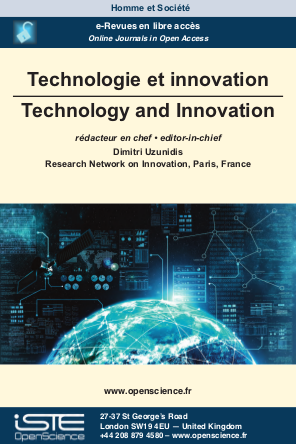

Social Sciences and Humanities > Home > Technology and Innovation > Issue
Our contemporary societies face an increasingly glaring paradox. While we live in a world that is produced – more and more – by technology, and the demand for innovation has never been stronger, the technical culture [CHO 17] is struggling to find its place in our society. However, technical culture is not only a means of removing individuals from their alienation [SIM 12] but also indispensable if we, as citizens, want to be able to participate in the reflection on the great contemporary challenges. This special issue wishes to contribute to the development of such a culture. To this end, an original perspective is borrowed, namely the innovation biography.
The article presents the history of an emblematic microcomputer, the Micral system, invented within the R2E company in the 1970s. It aims to show the interplay between levels of technical culture throughout this very complex innovation process: the omnipresence of technological skills, the importance of thinking about uses and users; and the reflexivity of the actors during the creation process – including echoes to the "small is beautiful" trend in the 1970s. Analysis at these various levels makes it possible to give meaning to the conception of Micral and its successive versions: in the 1970s, in a computer world dominated – in industrial terms and in terms of collective representations – by "mainframe" computers, Micral was invented and promulgated the very concept of the "microcomputer", long before the whirlwind of the IBM PC in the 1980s.
This paper presentsthe history of the TEL method, an innovation developed in the 1950s by ISOVER – a brand of the French company Saint Gobain – to produce glass fiber. The process’s history invites us to follow in the footsteps of a formidable human epic and adventureAt the same time, the TEL story proves that the lone innovator is a myth and that the innovation process is not magical and spontaneous. Similarly, it leads us to recognize the fact that innovation does not come out of nowhere, meaning that we need to consider its social depth. In this way, the history of the TEL method enables us to develop knowledge of how innovations exist, the third level of what we call “technical culture”. We therefore see, with the TEL example, how the story of innovation can contribute to the development of a technical culture.
The market incentive to invest in the invention and adoption of solutions would often be the driving force behind innovation, but when it comes to investing for the common good, it does not apply. This is the case with innovation in space waste disposal. The story of innovation in this field documents the engineering culture that accompanies the invention of a solution, which must also take into account a societal problem (the tragedy of the commons): how can we innovate when no one is willing to pay for the adoption of the invention? Using the Clean Space project as the focus, the article demonstrates that – far from being reduced to the business of a few heroes – innovation mixes different collectives that explore and interweave technical issues, the common good, financing, international standards, pedagogy and dreams. This paper begins with a teaching project based around a microsatellite; the result is a reversal of learning situations which enriches the technical culture of the collective concerned.
This article presents the story of a recent and unstabilized technological object: Zepcam – a type of body camera, worn by the police in the Netherlands. By examining the various inscriptions and translations that took place during its conception and introduction, the paper traces the extent to which the objectives, actions and ultimately the meaning of this technological object are formed and transformed when coming into contact with the various actors who appropriate it: policy-makers, designers and users. In doing so, it contributes to the shaping of a technical culture, which is essential for understanding the meaning of technological objects.
The street light à réverbères, also known as the “optical” street light, is an improved version of the ordinary street light which optimizes the luminous intensity of the lantern by using concave metal reflectors to direct the beam of light where needed. Although history chooses to focus on the Argand lamp, this article deals with a far less dignified and valued technical element: the reflector. From the technical scheme to its use, this paper presents the history of this lighting innovation, and seeks to shed light upon the multi-layered and entwined nature of this seemingly trivial and banal artefact.
This article sets to one side those brilliant inventors who are commonly thought of as pioneers, in favor of a more rounded reading of the innovation of photography over the course of the 19th century. Mapping the progress of innovation (here, understood as an investigation into the mode of existence of innovation, and as a vector for the development of technical culture) is told via an in-depth study that positions inventive activity as a specific moment of the innovation process. Patents are not only useful resources for inventors; they also bear testimony to continuous growth and specific trends. The study of the professions that deal with these issues – as much as the last stage, which seems to be the promotion and the disclosure of the inventions, as a rite of passage from invention to innovation – completes the activity of invention and offers another interpretation of photography, as a plural innovation linked to various factors, actors and issues.

2025
Volume 25- 10
Issue 12024
Volume 24- 9
Issue 12023
Volume 23- 8
Issue 12022
Volume 22- 7
Issue 12021
Volume 21- 6
Issue 12020
Volume 20- 5
Issue 12019
Volume 19- 4
L’innovation agile2018
Volume 18- 3
Issue 42017
Volume 17- 2
Mobility Innovations. Transport, management of flows and territories2016
Volume 16- 1
Issue 1